Using the New Curriculum
As you must be well aware, assessment in the Early Years is a challenge now that they have change the curriculum. At a recent course run by our LEA, we met with other practitioners and it seems that everyone is doing something different, but basically the same.
There are many types of observations that is common in every setting:
- Photographs
- Quick observations as would appear on a postit or a magic moment
- Catch as You Can observations
- Small group observations
- Large group observations
It’s not until you look specifically at the assessment sheets that you see the differences.
The priority for every setting is showing progress.
Photographs
Taking photos for observational evidence in the Early Years is essential. It captures the child’s activity in the moment and records their achievement.
When taking photos, it’s best to capture the child doing the activity and not ask the child to pose in the photo.
 |  | 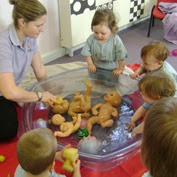 |
| picture from www.healthline.com | picture from hollycottagenursery.co | picture from beaufort.hants.sch.uk |
Once this photo has been recorded, it’s important to file the photos somewhere you may use them.
 This is known as a document tree, it’s what I use to organise the photos on my work computer.
This is known as a document tree, it’s what I use to organise the photos on my work computer.
The folders are stored in alphabetical order, you could create a Prime Areas and Specific Areas folder as well but I haven’t.
To create a new folder on a Windows machine, click on the New Folder button at the top of your documents window.
It’s very quick and simple to do and means that all your photo are easily found and used effectively in your assessment process.
What you do with your photos is an entirely different thing. Some settings use the photographs around the classroom but I think it’s nice to make a Learning Journey for each child to not only show progress through the year but also to allow the children to have a book they can look through to remember the year as they progress.
Magic Moments
A magic moment or a postit note observation is ideal for very quickly capturing something amazing that the children have said or done. I have my magic moment cards strategically positioned around my classroom in little plastic bags with a pen ready to be used at any moment.
I also have them with my Catch as You Can observations on clipboards should the person doing observations catch something amazing.
As you can see in these examples, little Joe Bloggs has said something amazing about space, sharing knowledge that he must have picked up from somewhere, possibly a space obsessed teacher. He has shown evidence towards Understanding the World: The World, 30 – 50 months, Can talk about some of the things they have observed such as plants, animals, natural and found objects. Talks about why things happen and how things work. And refers to the Understanding the World learning goals, They make observations … and
explain why some things occur. It also links to Communication and Language.
Little John Doe is showing a good understanding of sharing and thinking of other’s feelings.
These are just examples obviously but as you can see, both John’s and Joe’s Magic Moments are labelled with the references to the EYFS documentation and dated.
Catch as You Can Observations
A new element of the 2013 curriculum is Characteristics of Learning which need to be included on the children’s reports at the end of the year.
In my setting we decided that the best way to observe the children’s Characteristics of Learning was through Catch as You Can Observations.
We observe the children taking part in a free flow activity for a certain length of time and write what we observe. Once that is completed, the person who wrote the observation, be that a teacher or a teaching assistant or a supply teacher, will highlight the parts of the Characteristics that relates to what the child has done. Please see the example below.
Of course, judgements are subjective but I don’t think you can be wrong when you use your professional judgement.
We will complete one of these a term to get a developing picture of the child as a whole to inform the reports.
Small Group Assessment Sheets
 You will obviously be doing most of your teaching in small focus groups, as little children find it difficult to concentrate in large group situations.
You will obviously be doing most of your teaching in small focus groups, as little children find it difficult to concentrate in large group situations.
This sheet makes it possible for you to record short notes about the children’s attainment during this activity.
This information can be assessment for learning.
Large Group Assessment Sheets
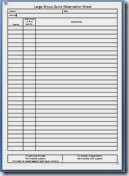 I generally use these sheets for very short note taking for an activity all the children will take part in.
I generally use these sheets for very short note taking for an activity all the children will take part in.
This could also be used to replace post it note observations as it keeps all the information on one page and makes it easier to find.
Literacy Assessment
Now that we aren’t using the points system from the EYFS Profile, it is difficult to show progress in the Early Years. To find a way to show progress I have produced a number of different tick sheets to show progress.
My idea was to produce something that was concise and clear but was also simple to maintain and wasn’t too time consuming. My aim was to make work manageable while at the same time being effective as a tool to demonstrate progress.
Writing Assessment Sheet
This sheet would go with an independent writing assessment. If you school does Big Write in Reception, you could use it to assess that, or if you choose to do an assessment piece each term you could use this as your marking sheet.
This piece of assessment shows progress as each time the page is completed, in theory the child would achieve more targets on the sheet. This also links to the Year One targets and can be used as a cross over piece of assessment for the Year One teachers.
Writing Progress Sheet
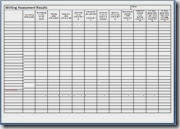 This sheet records evidence gathered from independent work that isn’t an assessment piece. Perhaps the children have written their name on a piece of work or they have written a card independently for the teacher or a friend.
This sheet records evidence gathered from independent work that isn’t an assessment piece. Perhaps the children have written their name on a piece of work or they have written a card independently for the teacher or a friend.
If one is completed each half term it can show progress as the children achieve more and attain higher through the year. As shown below..
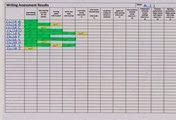 | 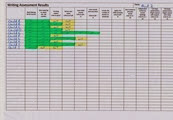 | 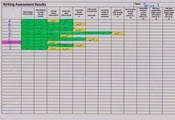 |
As you can see in this example, Children A and J are the lower attainers, Children B, C, F and H are the middle attainers and Children D, G and I are the higher attainers with child E doing very well.
All the children make steady progress from Autumn 1 to Autumn 2, but from Autumn 2 to Spring 1, Child H doesn’t make any progress and is hightlighted in pink.
I highlighted and ticked these sheets by hand but you could do it on the computer.
Reading Assessment
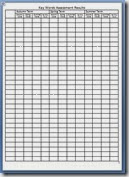 Using the 100 Key Reception Words from the Letters and Sounds Reading Scheme split into 3 terms with year one words for the higher attainers.
Using the 100 Key Reception Words from the Letters and Sounds Reading Scheme split into 3 terms with year one words for the higher attainers.
This sheet keeps in one place the results from the children’s reading assessments. You will know exactly who is making reading progress and how many of the key words every child in your class is able to read.
Phonics Assessment

Maths Assessment
Using the Early Learning Goals and the developmental stages from the Development Matters 2013, I picked out some main elements of Mathematics that could show progress through the year. This does not cover all the elements of Mathematics, however, but this tick sheet could help in showing progress.
 |  |
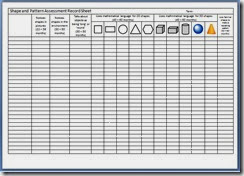 | 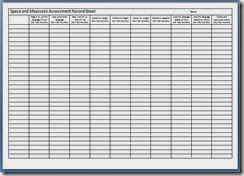 |
These work the same as the writing progress sheet, as it shows progress as the children attain more through the year.
Progress in Other Aspects of the Early Years
Collecting evidence for judgements is essential in the Early Years. The new curriculum says that teachers’ observations and judgements do not need to be backed up with a lot of paper work. The idea of the new curriculum is that we are no longer stuck behind clipboards and tick sheets, the idea is that we now work with the children.
Realistically, moderators and OFSTED like to see progress written down. I know that little Jimmy started Reception hiding under a table and not talking to anyone, certainly not holding a pencil and now in the Summer term, he’s writing sentences, has a best friend and likes singing in front of the class. That’s huge progress but showing it written down isn’t always easy.
This is where the photographs and post it notes come into their own. Labelled and organised post it notes/magic moment cards and organised photographs can show a development in social skills, art and imagination skills, improvements in behaviour, etc. as well as a comprehensive baseline assessment.
Baseline Assessment
I am constantly changing my baseline assessment depending on how effective I found the previous year for informing assessment for learning.
I aim to complete my baseline assessment by the end of the first full week of term, but this isn’t always possible.
When choosing what to include in your baseline assessment, I think it’s important to include some basic elements of reading, writing and maths as well as focusing on elements of behaviour and social skills, as well as an interest in art.
Please check back for more on Assessment, or see the Assessment Page.

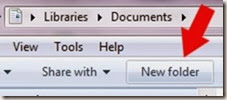

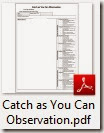


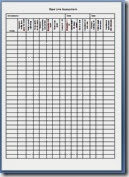
Wow brilliant resources thank you. Your site is just what I need - I am a teacher entering the world of reception after teaching in y1 and 2 for 11 years! How can I download these files as PDF?
ReplyDeleteThank you for your comment Archee! If you click on the images that should lead to my Google sky drive so you can download from there. All my resources are free to download.
DeleteLet me know if anything else would be useful.
thanks for sharing your project....to get Online pharmacy from Dose Pharmacy
ReplyDeleteI have become happy to have a look at this newsletter after searching at google, after reading I have written a chunk of the article about back pain : Thank you for the thing and supporting me.
ReplyDelete